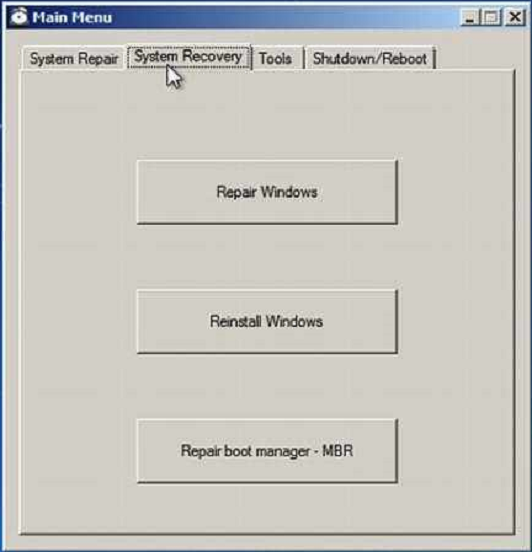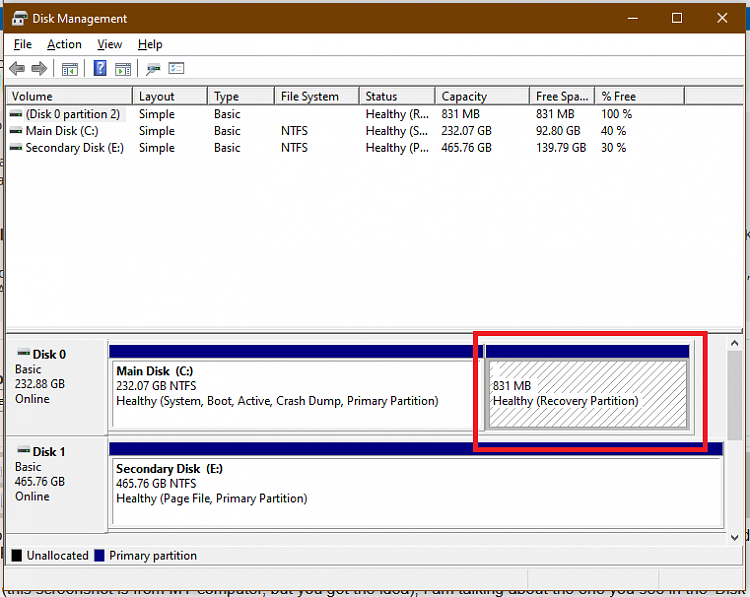Use Internet Recovery to reinstall macOS on Mac with a missing recovery partition. Jump to this section to find out how to do that. Create a bootdrive to install a copy of macOS from. But an easier approach is to use the free Recovery Partition Creator (more info here).This app can create the partition and even install the necessary OS X Recovery software on it. Creating a macOS Recovery Partition without reinstalling OSX or re-running your installer // under mac macOS recovery. Restoring from a Time Machine backup - at least for me - won’t furnish you with a Recovery partition. This is bad news because the only official way of getting a recovery partition is to reinstall macOS. I've got Catalina running on my 4,1 (5,1) for a few months now, and has been working without much trouble. Though recently I tried to disable SIP via the recovery partition (was unnecessary because using DosDude1's patcher automatically disables SIP) and found out that my recovery partition was non-existent. When you click the button to create a new Recovery HD volume, CCC will do the following: Unmount the donor disk. Perform the equivalent of Disk Utility's 'Verify disk' tool. Resize the donor volume to (size of the donor volume) - 1GB. Create a new volume named Recovery HD using the 1GB of borrowed space.
- Recovery Partition Creator Catalina
- Recovery Partition Creator Catalina Free
- Create Recovery Partition Catalina
macOS Catalina is a hugely exciting upgrade for the Mac. In some ways, it’s like having a completely new computer. You may have already taken the plunge and installed it, or maybe you’re waiting to see how it settles down before you install it. But whichever camp you’re in, it’s a good idea to create a bootable installer for macOS Catalina. That way, if anything goes badly wrong with your Mac, you’ll be able to boot from the installer and get going again quickly.
Why do I need a bootable installer for macOS Catalina?
There are a number of reasons for creating a bootable USB Mac installer.
- If you have more than one Mac, it allows you to install Catalina on all your other Macs without having to download it from the App Store each time.
- You may want to clean install Catalina, in which case you’ll completely wipe your startup disk and will need to boot from an external drive to do that.
- It’s good protection against a catastrophe striking your Mac’s startup disk, especially if you don’t have a stable internet connection. Normally, if you need to reinstall macOS, you can just boot from the recovery partition and do it from there. However, that means re-downloading the installer. So, if you don’t have an internet connection or it’s very slow, you need an alternative.
What should I use as a bootable installer?
You can use an external hard drive, an SSD or a USB stick. Anything that has at least 16 GB of free space. You’ll need to create a new partition (or container if it’s formatted as AFPS) for the installer so if you have data on it you need, you should copy it to another drive first.
How to create a bootable USB drive for macOS Catalina
Whoa! Not so fast. There’s one more thing you should do before you create the installer: clear out the junk on your Mac. Before you undertake any major task on your Mac, and especially before you install a new version of the operating system, you should clear out junk and old files you no longer need. I don’t normally recommend software tools, but in this case, the nest way to clear out the clutter is to use CleanMyMac X. It can scan your Mac at the press of a button, identify all the files you don’t need, and allow you to get rid of them with one more click. Here’s how to use it:
- Install, and launch CleanMyMac X — download a free edition here
- Choose Smart Scan from the list of utilities in the sidebar.
- Press Scan.
- When it’s finished, press Run to delete files immediately, or Review Details to see what it has found.
Once you’ve cleared out the clutter, you can go ahead and create your bootable installer. Here’s how:
- Launch the App Store app and search for macOS Catalina. (If you’re reading this before Catalina has been launched, you’ll need to use the public beta. You can sign up for Apple’s public beta program and download it here Apple Beta Software Program)
- When the results appear, click on Catalina, then click ‘Get’.
- Wait for it to download. When it’s finished, the installer will launch. Quit it immediately.

The installer has now been saved in your Applications folder. You can go ahead and check, if you like. You now have two options for creating the installer. If you’re comfortable with using Terminal, you can go ahead and jump to the instructions for that, below. If you’d rather not use Terminal, there’s a neat utility called Diskmaker X that will do it for you. All you need to do is download and install it and then, when you run it, point it to the macOS Catalina installer you just downloaded. There are full instructions on the download page.
How to create a bootable installer using Terminal
- Plug the USB stick, hard drive or SSD into your Mac.
- Go to Applications>Utilities and double-click Disk Utility to launch it.
- Select the disk you want to use for the installer and choose the Erase tab.
- Choose APFS or Mac OS Extended (Journaled) as the format and choose GUID partition map from the options, if it’s available.
- Give the disk a name and press Erase.
- When it’s finished, quit Disk Utility.
- Go to Applications>Utilities and double-click Terminal to launch it.
- Type:
sudo /Applications/Install macOS Mojave.app/Contents/Resources/createinstallmedia —volume /Volumes/Untitledwhere ‘Untitled’ is the name of your USB stick or external hard drive
- Press Return and wait for the word Done to appear in Terminal.
- Quit Terminal
You now have a macOS Catalina installer on an external disk or USB stick. Eject it, unplug it and keep it safe. You can use it to install Catalina on any Mac that supports it.
One more step: update applications
Once you’ve used tour new installer to install Catalina on a Mac, it’s a good idea to update all your applications so that that are Catalina compatible. You can do this manually, from the App Store and by launching non-App Store apps and choosing check for updates, but that’s a long and tedious process. It’s much quicker and easier to use the updates in CleanMyMac X. Here’s how you do it.
- Launch CleanMyMac X.
- Select the Updater tool in the Applications section.
- Press Select All.
- Press Update.
And that’s it. You’re done. CleanMyMac X checks all your installed apps for updates and then updates them all.
Creating a bootable installer for macOS Catalina isn’t difficult. If you have a spare disk or USB stick and are comfortable using Terminal, you can do it right away. If you’d rather not use Terminal, use the Diskmaker X tool described above. Whichever method you use, make sure you use CleanMyMac X to clear out the junk on your Mac before you start, and use it again to update your applications when you’ve finished.
“I was in the middle of extending one of my Mac partitions, when my MacBook froze. Then, I restarted it manually using a hard reboot, but now I’m missing that entire partition. Can I know how to recover lost partition of Mac?'
With the above given user statement, you can understand that people experience loss or deletion of their existing MacBook partitions when they are trying to extend or divide the volumes. Data that was present within these partitions will be permanently deleted or lost. Luckily, you can recover your Mac partition with the help of Remo Recover software. This is one of the best partition recovery software’s that will help you to perform partition recovery on your MacBook with ease.
How Do I Recover A Mac Partition?
When your partition is deleted or goes missing, the operating system indicates that the files present on this sector have been lost due to a certain reason and are ready to be overwritten. However, these ready to be overwritten files can be traced and the data can be recovered with Remo Recover Mac if no new data is stored. This Mac data recovery software is built with a robust scan algorithm that crawls through every sector of your Mac partition and recognizes files that are marked as deleted or lost.
The advance scan feature of Remo Recover Mac can identify more than 300+ file types on your MacBook partition which makes the recovery process very effective.
Given Scenarios Where You Can Recover OS X Partition with Remo Recover:
- Can recover accidentally deleted/ formatted Mac partitions
- Can get back partitions lost due to software conflicts and improper partition resizing
- Can retrieve partitions lost due to excessive bad sectors
- Can recover partitions from a crashed Mac hard drive
- Can restore partitions lost due corrupt partition Map on your MacBook
- Can recover data from inaccessible Mac volumes
Remo Recover supports recovering deleted partitions from HFS, HFS+, APFS, FAT16, FAT32 & ExFAT file systems and for all Mac devices like MacBook Pro, MacBook Air, MacBook, iMac etc. it is a highly compatible tool.
How to Recover Deleted Partition On Mac?
Download, install and launch Remo Recover Mac application on your MacBook.
Step 1: From the main screen, select Recover Volumes / Drives option followed by the Volumes Recovery option .
Step 2: Select the Mac drive from where your partition was deleted or lost and click Next.
Step 3: Select the Advance Scan option if you have formatted or stored any new data by mistake .
Step 4: Select the file types that you want to recover from your deleted or lost Mac partition and click on Next.
Note: If you want to recover all the files from the Mac partition, click on Skip.
Step 5: Once the scanning process is completed, click on a specific file and click on the Preview button to verify the file before proceeding to save .

Other Functionalities of Remo partition recovery Software
Remo Mac Recovery software provides a self-explanatory approach to recover volumes on Mac. With clear instructions at every step, this tool makes Mac partition recovery easy for all users.
Recovery Partition Creator Catalina
- Supports APFS, HFS, HFS+, FAT16, FAT32 & ExFAT file systems
- Works on Catalina, Mojave, High Sierra, Sierra, El Capitan, Yosemite and older versions
- Supports MacBook Pro, MacBook Air, MacBook, iMac, iMac Pro etc.
Recovery Partition Creator Catalina Free

Things to Do to Prevent Losing or Deleting Data from Mac Partitions:
Create Recovery Partition Catalina
- Enable Time Machine Backup on your MacBook
- Do not perform abrupt hard reboot as it leads to data loss of any ongoing process and causes your MacBook to crash
- Do not try to resize your Mac partition without proper knowledge



